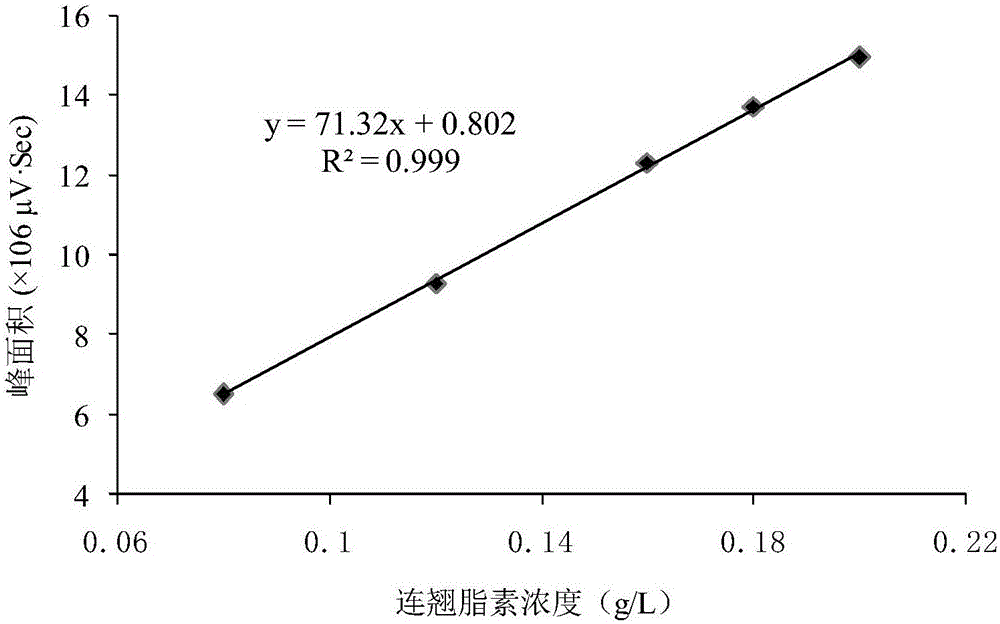Penicillium citrinum LB and application in forsythiaside preparation through biotransformation of forsythin
A technology of Penicillium citrinum and biocatalyst, applied in biochemical equipment and methods, methods based on microorganisms, microorganisms, etc., can solve the problems of large enzyme consumption, achieve good specificity, less environmental pollution, and less by-products Effect
- Summary
- Abstract
- Description
- Claims
- Application Information
AI Technical Summary
Problems solved by technology
Method used
Image
Examples
Embodiment 1
[0031] Isolation and screening of embodiment 1 transformed strain
[0032]Collect fertile soil from flower beds and dilute 1×10 with sterile water 6 Spread on the potato dextrose agar plate medium (PDA) after doubling, and cultivate at 28°C for 4 days, pick mold colonies with different colors and shapes and transfer them to fresh PDA plate medium, and place them at 28°C for 3 days. 12 strains with abundant spores were obtained (see Table 1 for the strain numbers), which were stored in a refrigerator at 4°C for later use.
[0033] Pick 2 rings of spores on the plate culture medium of each of the above-mentioned bacterial strains with inoculation loops, inoculate them into 100mL initial fermentation medium (250mL Erlenmeyer bottle), shake and culture at 30°C and 200r / min for 3 days (fermentation broth of different strains The concentration of the dry cells is between 1.42g / L~4.37g / L), and 1mg of forsythin is dissolved in 1mL of methanol and then added to the fermentation broth,...
Embodiment 2
[0044] Embodiment 2: Stability verification of bacterial strain LB transformation
[0045] Using strain LB as the transformed strain, under the fermentation scale of 100mL shake flask, the step of expanding seed cultivation was added, and the fermentation broth containing bacteria was used to transform forsythin to verify the transformation stability of the strain. The specific process steps are as follows:
[0046] (1) Inoculate the bacterial strain LB plate bacterial classification preserved in 4 ℃ of refrigerators on fresh plate culture medium, and plate is cultivated at 28 ℃ of constant temperature for 2 days, and described plate medium composition and preparation method are the same as embodiment 1;
[0047] (2) Use an inoculation loop to take the spores of the strain LB after the activation of step (1) into 50mL seed medium twice, and cultivate them at 30°C and 200r / min constant temperature oscillation for 2 days to obtain a dry cell concentration of 1.83g / min. Seed solu...
Embodiment 3
[0051] Embodiment 3: the taxonomic identification of bacterial strain LB
[0052] The strain LB was inoculated on the potato dextrose agar plate medium, and cultured at 28°C for 2 days to grow colonies. The colony is white and fluffy at the beginning, and then the surface gradually turns gray-green, producing a large number of green conidia, and the back is yellow. Under the microscope, it was observed that the hyphae had a septum, and clusters of blue conidia were produced on the top of the sporophyme, and the conidia spikes were in the broom-like shape unique to Penicillium species.
[0053] The strain LB was submitted to Sangon Bioengineering (Shanghai) Co., Ltd. for 18S rDNA sequencing, and the measured sequence size was 1282bp. The specific sequence (shown in SEQ ID NO: 1) is as follows:
[0054] GCTCATTAAATCAGTTATCGTTTATTTGATAGTACCTTACTACATGGATACCTGTGGTAATTCTAGAGCTAATACATGCTACAAACCCCGACTTCAGGAAGGGGTGTATTTATTAGATAAAAAACCAACGCCCTTCGGGGCTCCTTGGTGAATCATAATAACTTAACGAATCGCATG...
PUM
 Login to View More
Login to View More Abstract
Description
Claims
Application Information
 Login to View More
Login to View More - R&D
- Intellectual Property
- Life Sciences
- Materials
- Tech Scout
- Unparalleled Data Quality
- Higher Quality Content
- 60% Fewer Hallucinations
Browse by: Latest US Patents, China's latest patents, Technical Efficacy Thesaurus, Application Domain, Technology Topic, Popular Technical Reports.
© 2025 PatSnap. All rights reserved.Legal|Privacy policy|Modern Slavery Act Transparency Statement|Sitemap|About US| Contact US: help@patsnap.com



